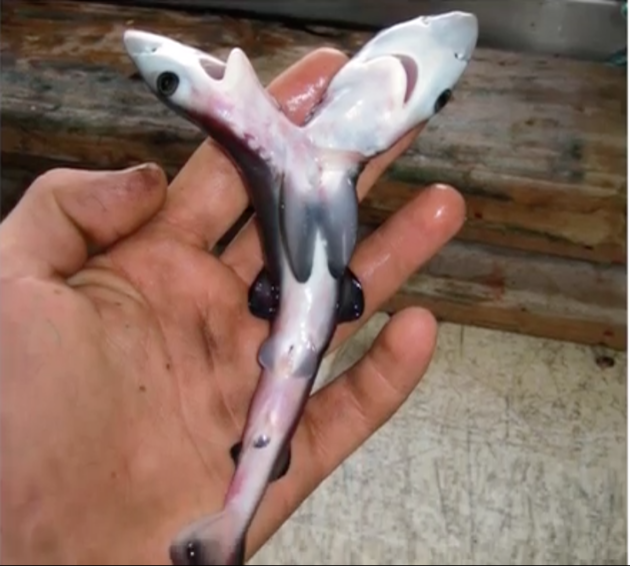Note: Header/cover image is not real
Last month, a group of Spanish scientists using Atlantic sawtail catshark eggs to research cardiac health in humans discovered an embryo with two heads. Earlier this year, marine scientist Nicolas Ehemann published a study that explored two other examples of two-headed sharks. This one focused on embryos of a blue shark and a smalleye smooth-hound shark, respectively.
This phenomenon is more properly known as polycephaly, the genetic abnormality that causes an embryo to develop two heads. But the frequency of cases seems to be increasing. Historically, scientists theorized that polycephaly only happened in sharks that give birth to live young, such as blue sharks. The two-headed sawtail catshark reproduces by laying eggs, however, disproving the theory.

Two-headed sharks are becoming more common
The first-known example of shark polycephaly dates to 2008. Australian longline fisherman Christopher Johnston caught a pregnant blue shark in the Indian Ocean and found a two-headed embryo inside the body. In 2011, the journal Marine Biodiversity Records published a study on polycephaly in blue sharks after several more mutated embryos were discovered inside a female caught off the coast of Baja California.
Polycephaly occurs when twins fail to separate fully in the womb. This phenomenon can affect any living creature, including humans. The blue shark seems to be particularly prone to polycephaly, however. Ehemann’s 2016 study documented the eighth known case in blue sharks. The leader of the 2011 study, Felipe Galván-Magaña, hypothesized that this propensity is related to the blue shark’s high embryo count. The sharks can produce up to 134 pups at a time.
What’s going on?
However, a two-headed bull shark discovered off the coast of Florida in 2013 suggests that there is more to the phenomenon that embryonic over-crowding. Unlike blue sharks, bull sharks have relatively small litters of between one and 13 pups. In fact, with every new two-headed specimen discovered, scientists are becoming increasingly confused as to the cause.
Scientists incubated the sawtail catshark in a lab,. It was the only one of nearly 800 eggs to develop with polycephaly. Study leader Valentín Sans-Coma thinks that a genetic disorder is to blame, since researchers kept the eggs in a sterile environment with no contact from chemicals or disease. However, the jury is out as to what could cause polycephaly in wild sharks. So far, theories range from viral infections to the effects of marine pollution.
Galván-Magaña asserts that there may not be an increase in the number of two-headed sharks at all. Instead, he thinks that science and social media have simply advanced in recent years such that unusual discoveries (like two-headed sharks) quickly go viral. Ehemann, on the other hand, thinks polycephaly is increasing, and that reduced gene pools caused by overfishing are to blame.
Whether two-headed sharks are becoming more common or not, Ehemann acknowledges that examples are still too rare to allow for a reliable study of the phenomenon’s causes. As divers, we’re also unlikely to encounter two-headed sharks underwater, because their mutation makes survival past infancy improbable.

